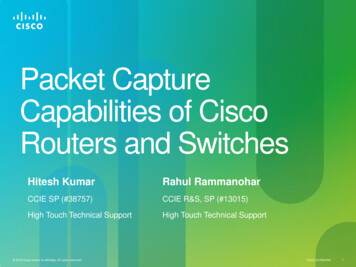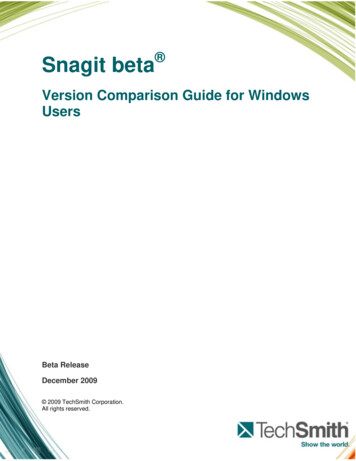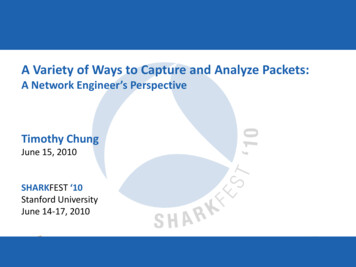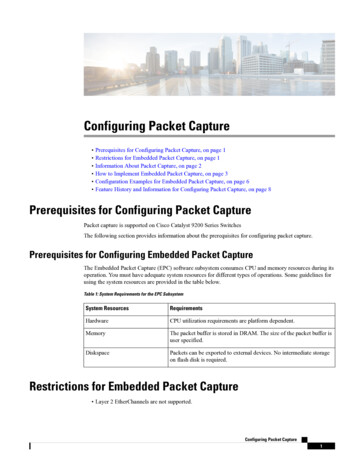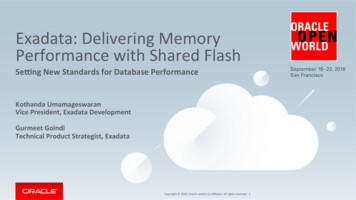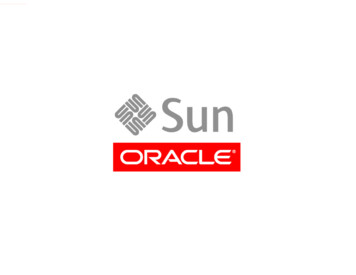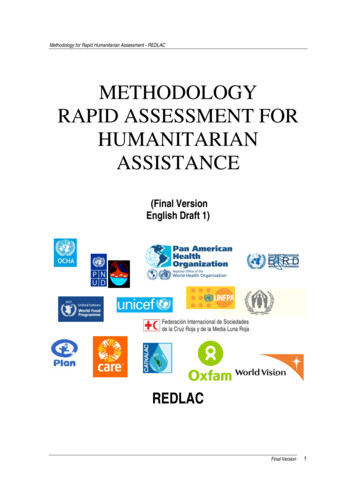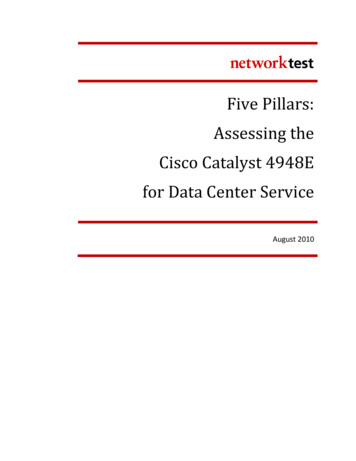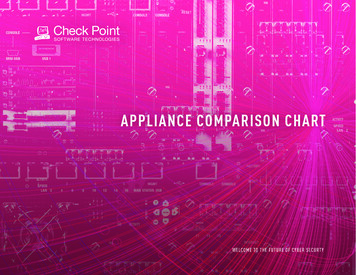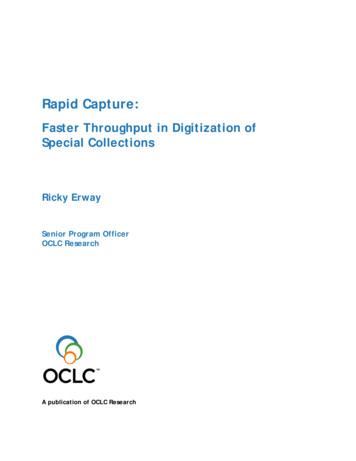
Transcription
Rapid Capture:Faster Throughput in Digitization ofSpecial CollectionsRicky ErwaySenior Program OfficerOCLC ResearchA publication of OCLC Research
Rapid Capture: Faster Throughput in Digitization of Special CollectionsRicky Erway, for OCLC Research 2011 OCLC Online Computer Library Center, Inc.Reuse of this document is permitted as long as it is consistent with the terms of the CreativeCommons Attribution-Noncommercial-Share Alike 3.0 (USA) license by-nc-sa/3.0/.April 2011OCLC ResearchDublin, Ohio 43017 USAwww.oclc.orgISBN: 1-55653-398-5 (978-1-55653-398-3)OCLC (WorldCat): 712406431Please direct correspondence to:Ricky ErwaySenior Program Officererwayr@oclc.orgSuggested citation:Erway, Ricky. 2011. Rapid Capture: Faster Throughput in Digitization of Special Collections.Dublin, Ohio: OCLC Research. 2011/201104.pdf.
Rapid Capture:Faster Throughput in Digitization ofSpecial Collections
Table of ContentsIntroduction . 5Archives of American Art, Smithsonian Institution . 6Indiana University . 7Library of Congress . 9The Bancroft Library, UC Berkeley . 10University of California, Los Angeles . 11University of Minnesota: Green Revolution . 12University of Minnesota: University Archives . 14University of North Carolina . 15The Walters Art Museum . 16So, what to make of this? . 17Appendix . 20References . 23
Rapid Capture: Faster Throughput in Digitization of Special CollectionsIntroductionBack in the day, we used to think digitizing pictures was easy; digitizing books was difficult.Books have parts and order and hierarchy—and text! Then Google (and Internet Archive, andKirtas, and ) showed us how quick and easy digitizing books could be. Suddenly it seems asthough we’re all saying digitizing books is easy; digitizing everything else is difficult.OCLC Research has been chipping away at the question of why digitizing special collections isso, well, special. How could it be made a bit more ordinary, routine, affordable, andeffective? In 2007, we published Shifting Gears (Erway and Schaffner 2007), which took theposition that for special collections we’re going to preserve the original, so why be obsessedwith preservation-quality digitization? Digitize for access! Better isn’t more. More is better.Last year, OCLC Research took on some of the rights issues related to special collections, withthe Undue Diligence event (2010a) and the subsequent community of practice (2010) that hasformed around the Well-intentioned Practice document (2010b), which argues that we shouldbe less risk-averse. We shouldn’t be the ones saying “No” to digitizing unpublished works. Ifthe copyright holders come forward, give them a chance to say it. (They rarely do.)In between we have made other forays to help increase the scale of digitization of specialcollections. (See Supply and Demand [Erway 2008] on users’ changing expectations, GoodTerms [Kaufman and Ubois 2007] on commercial partnerships for digitization, Capture andRelease [Miller 2010] on digital cameras in the reading room, and Scan and Deliver [Schaffner,Snyder, and Supple 2011] on patron-initiated digitization.)In this study, we look at the actual digital capture part of the process. Google et al. figuredout how to maximize throughput for book digitization; have there been any similarinnovations for the digitization of other formats? In hardware? In workflow? In attitude? Ourinquiring minds wanted to know.So in an extremely casual survey, we asked some of our colleagues in libraries, archives, andmuseums to identify initiatives where non-book digitization was being done “at scale.” Wedidn’t define “at scale,” because we thought we’d know it when we saw it. It wasn’t alwaysso easy. We heard from lots of places: some with minor achievements, others making a bigdifference. We selected a few of the latter stories to share with you here. Each one startswith a picture of the equipment in use at the site along with a sample from the collectionbeing digitized. Additional details can be found in the /library/2011/2011-04.pdfRicky Erway, for OCLC ResearchApril 2011Page 5
Rapid Capture: Faster Throughput in Digitization of Special CollectionsWe hope these vignettes will encourage others to consider whether any of these approachesmight be applied to their own projects to increase the scale of their digitization efforts.Ultimately, we hope these gleanings will contribute to increasing access to special collections.Archives of American Art, Smithsonian InstitutionSeries 4: Photographs and Scrapbooks.Reproductions of Artwork. Installation Views, 19461951. (Box 26, Folder 4, No. 46) Walt Kuhn Familypapers and Armory Show records, 1859-1978.Archives of American Art, Smithsonian Institution.The Archives of American Art is doing large-scale digitization of entire manuscript collectionsfrom originals and from microfilm, linking the resulting images to the finding aids thatdescribe the collections. The collections contain manuscripts, photographs, slides,sketchbooks, scrapbooks, diaries, postcards, posters, and rare published materials. A 2005grant from the Terra Foundation of American Art allowed them to carry this work forward.They have digitized 110 collections representing 1,015 linear feet of manuscript collectionsand 442 reels of microfilm—over 1.5 million images.The Archives uses two Zeutschel overhead planetary scanners acquired from The CrowleyCompany. In late 2010, they received Phase One equipment from Digital Transitions, Inc. TheZeutschel takes 7-10 seconds to capture grayscale at 300 dpi. The Phase One takesapproximately one second per scan in color. With the Phase One camera, they are nowscanning everything in color and at a significantly faster speed. The Archives has developed aremarkable software system to track the process from beginning to end, coordinating 16 steps(processing, scanning, quality control, creation of derivatives, approvals, etc.) and linking thedigital images to the finding aids.Outsourcing: The Archives has outsourced some microfilm scanning to Crowley and some toModern Microimaging. Capture from originals was done exclusively in house until 2010, ary/2011/2011-04.pdfRicky Erway, for OCLC ResearchApril 2011Page 6
Rapid Capture: Faster Throughput in Digitization of Special CollectionsCrowley began digitizing selected collections from originals. In the past 18 months Crowleycompleted 206 linear feet of originals. Since they can have more than one capture streamworking on different sections of the collection, they can complete far more than can bescanned in-house.Throughput: At the Archives, one operator can scan 1 ½-2 linear feet per week, sometimesas many as 500 images per day.Bottlenecks in other parts of the process: Standard appraisal processes are inherently timeconsuming. Processing takes about the same amount of time as capture.Of note: The Archives of American Art was able to attempt large-scale digitization due to itshistory of microfilming entire collections ever since its founding in 1954 and continuously upuntil 2005, when they replaced their microfilm operation with digital capture. Microfilminginvolved creating 7 sets of film for regional AAA offices and affiliates, required a painstakingquality-control process, making labels, supporting ILL—they’ve shown significant benefits inworkflow and accessibility by switching to a digital workflow.Indiana UniversityRecording Formats. Kevin Atkins. Courtesyof Indiana University.The Archives of Traditional Music is exploring issues related to the digitization of audio forpreservation and access. Through grant funding and ongoing conversion of various at-riskmedia, their research focuses on automating as much of the process as possible and workingon fast, accurate means of transfer to digital form. While they work with many types ofmedia, we focused on their work with audio recordings on cassette tapes.Indiana University has undertaken research to develop safe practices for parallel transfer,which is the digitization of multiple recordings simultaneously. They can process threecassette tapes at the same time. They have two banks of three cassette decks and, as thefirst set is being transferred, the second set is being prepared. An audio engineer monitorsthe three decks via software that automatically brings each of the three sources into primaryfocus (higher volume by 12-15 db) for a short amount of time (10-15 seconds). The s/library/2011/2011-04.pdfRicky Erway, for OCLC ResearchApril 2011Page 7
Rapid Capture: Faster Throughput in Digitization of Special Collectionscan always hear all three recordings, so has continuity, but focuses on one at a time. Thisapproach allows comparison from one source to another (batches consist of similar materials),so the technician can make constant comparisons to listen for subtle shifts in fidelity.Throughput: Although audio must be digitized at playback speed, the three-source approachis more than three times more efficient than doing one at a time. They have also automatedmuch of the post-processing activity to run in overnight batches so that metadata isembedded in files and entered into a database, derivatives are created, and files are copiedand checksums verified by software applications.Outsourcing: While Indiana University is fortunate to have a wide range of in-house expertiseand equipment, most sound archives do not. It may be more efficient to outsource to anexperienced service provider with expert engineers, skilled technicians, and an array ofsoftware and hardware devices. Service providers have streamlined workflows, can handlemultiple streams, and are often far less expensive than establishing in-house capabilities.Bottlenecks in the capture process: An important part of the process is selection. They haveto select stable, suitable materials for parallel transfer, while directing unsuitable recordingsto a custom 1:1 transfer process. If there’s a problem with one of the tapes, they have tostop and put it in the cue for special handling and investigation.Of note: Unlike other types of materials, when it comes to sound (and video) recording,there are no long-lived analog formats. Everything must be converted to digital forpreservation and access. Content that is on obsolete media or that is degrading is especiallyat rary/2011/2011-04.pdfRicky Erway, for OCLC ResearchApril 2011Page 8
Rapid Capture: Faster Throughput in Digitization of Special CollectionsLibrary of Congress“Fiddlin” Bill Henseley. Asheville, NorthCarolina. Photographer: Ben Shahn. Library ofCongress, Prints & Photographs Division, FSAOWI Collection, [LC-USF33-6258-M1].The Library of Congress is digitizing 23,000 Farm Security Administration 35mm nitrate filmnegatives. The work was outsourced to CSC, Inc. who used equipment from Stokes Imaging,Inc. The equipment consisted of a digital camera, transmissive lighting, a table topsufficiently anchored to safely handle materials and limit vibration, a negative carrieradapted to hold strips of film flat (the film is manually loaded but the carrier is automaticallycontrolled), and an enclosed workspace with filtered air to reduce dust.Throughput: Three staff (one production manager and two technicians), work eight-hourworkdays and capture about 500 frames per day.Outsourcing: Digital conversion efforts are entrusted to experts who can focus solely on thattask. Vendors can quickly upgrade or change technology as requirements change from projectto project, or as capture technologies rapidly improve.Bottlenecks in the capture process: The startup phase is the most time-consuming astechnical specifications are confirmed and aesthetic expectations are honed. Some problemsoccur with film curl, film stuck to housing, and mismatches between collection inventory andmaterials in hand.Bottlenecks in other parts of the process: Handling physical media deliveries, post-scangamma/tonality adjustments, and delivering large file sizes and quantities all take time.Despite mechanical and technical conveniences, a good eye for quality, an understanding ofhow photographs should “look,” and overall visual literacy skills are required. Setting andcalibrating aesthetic quality expectations can be difficult and slow, but are worth the upfront investment.Of note: Concurrent with a process to make preservation film copies of the deterioratingnegatives, these photos were originally digitized in the early 1990s as a by-product y/2011/2011-04.pdfRicky Erway, for OCLC ResearchApril 2011Page 9
Rapid Capture: Faster Throughput in Digitization of Special Collectionscreating a videodisc. The low-resolution images have proved so popular as to warrantre-scanning at far superior quality.The Bancroft Library, UC Berkeley“Letter from John Muir to Helen[Muir Funk], [1914 Jun?].” JohnMuir Correspondence. TheBancroft Library, University ofCalifornia at Berkeley.The Bancroft Library and the University of the Pacific Library’s John Muir Correspondenceproject, funded by The Library Services and Technology Act, outsourced digitization of a 1985microfilm set from high quality, duplicate positive microfilm made from the original negatives.The 22 reels (containing 6,500 letters) were scanned by OCLC Preservation Services (sinceacquired by Backstage Library Works) resulting in 24,800 total image files. The vendor usedtwo NextScan Eclipse scanners. A technician made the initial settings for each reel to get thebest output per reel. Once a test scan was accepted, the frames on the reel were scannedautomatically. After image capture, images were checked in the NextScan Audit software andthen auto-cropped and de-skewed in Photoshop.Throughput: Approximately six 100 foot reels per day per scanner—about 4800 images perday.Outsourcing: Microfilm scanning can usually be done most cost-effectively using a vendor.Reels are not original materials, so can be shipped off-site without the high cost (insurance,specialized shipping) of sending original materials. The microfilmed materials can be scannedfor a fraction of the cost of doing the work in-house from the s/library/2011/2011-04.pdfRicky Erway, for OCLC ResearchApril 2011Page 10
Rapid Capture: Faster Throughput in Digitization of Special CollectionsBottlenecks in the capture process: Some of the more time-consuming tasks includeddetermining how to handle all the varied “assets” on the film (metadata and targets),filenaming protocols, and dealing with unsprocketed film and inconsistent frame sizes.Bottlenecks in other parts of the process: It takes time to duplicate the microfilm, clearrights and transcribe text.Of note: Anytime scanner throughput can be increased, costs are reduced. Doing work inquantity and grouping materials by size so that equipment adjustments are not necessaryreduces the overall cost of capture. The Bancroft Library has successfully reduced costs onhigh-end capture by 80% and more using this methodology.University of California, Los AngelesSafety Last!, a 1923 silent romanticcomedy starring Harold Lloyd.The Collection of Motion Picture Stills consists primarily of American motion picture stillsdating from the 1920s to the present. The collection includes black-and-white prints and asmall amount of color prints and slides. The photographs include set and scene shots as wellas publicity stills. The collection represents films produced by various companies includingColumbia Pictures, 20th Century Fox, MGM, Paramount, Republic, RKO Universal, UnitedArtists, Warner Brothers and more. The stills are well-used and are stored off site;digitization will increase access to the collection.Stokes Imaging installed a newly designed scanning station at the Southern Regional LibraryFacility (SRLF) for testing and evaluation as a mass-digitization option. Plans and preparationbegan in 2008/09. With funding from the UCLA Library, two new workstations for rary/2011/2011-04.pdfRicky Erway, for OCLC ResearchApril 2011Page 11
Rapid Capture: Faster Throughput in Digitization of Special Collectionscapture and processing were provided at the SRLF, along with expanded storage capacity,1.25 FTE staff, and support from UCLA’s Digital Library and Cataloging/Metadata staff. Inaddition to digitizing the Motion Picture Stills Collection, project staff have also scanned theAldous Huxley Collection and will continue through 2011 with additional photo and manuscriptcollections.Throughput: About 400 images per day, with 5-6 hours of scanning and 2-3 hours ofprocessing. Image resolution ranges from 300-2,400 ppi. Throughput rate can be as high as165 images per hour at lower resolution.Bottlenecks in the capture process: The new setup had a lot of startup delays (installation,training, and several months of working with the new Stokes Imaging Workflow Solutionsoftware). Photographs that are old and poorly preserved can be problematic and glossyphotos can cause glare in images.Bottlenecks in other parts of the process: Moving digital files (physical media delivery anddata storage on server directory) causes some delays.Of note: UCLA has now purchased the Stokes Imaging equipment and in 2011 may add asecond operator to improve/increase productivity.University of Minnesota: Green RevolutionUntitled field notebook, 1953.Norman E. Borlaug Papers.University of Minnesota Archives.In the eleven-month, grant-funded, Green Revolution Scanning Project, Archives and SpecialCollections estimates it will scan 198,350 selected documents and photographs (notebooks,loose sheets, photo albums, news clippings) from personal and alumni papers anddepartmental records. Documents that are under copyright, such as publications, andmaterials that are routine in nature, such as invitations and cards, were not scanned.The Green Project uses an i2S CopiBook HD (from French Firm i2S Innovative Imaging Solutions;US vendor IImage Retrieval) and two free-standing fluorescent lights. Four students do thebulk of the scanning in two daily four-hour shifts. Before scanning, the documents ry/2011/2011-04.pdfRicky Erway, for OCLC ResearchApril 2011Page 12
Rapid Capture: Faster Throughput in Digitization of Special Collectionsprepped by student staff, removing paperclips and staples. The students scanning thecollections also prep the documents.Throughput: They average 1536 scans per day.Bottlenecks in the capture process: Actual image capture (i.e., not including any postscanning quality control and processing) remains the fastest part of the overall process.Bottlenecks in other parts of the process: Quality control continues to provide the largestbottleneck. In order to ensure fidelity of capture and to avoid any missed page scans thesampling size is incredibly large. Other bottlenecks currently are batch upload into therepository and discovery environment. They are working to effectively integrate a batchloader into the system, but even so, loads at this scale are time consuming. They would liketo better leverage technology to help shepherd image files through the system. Currently, anumber of human interactions need to take place to trigger certain events: JPEG 2000conversion, OCR, batch upload. In the future they would like to incorporate an improvedprocess that takes care of these hand-offs.Of note: They are not creating metadata for the scans, beyond the file names created as partof the process. They are using the folder titles (and in some cases box titles) as themetadata so the existing finding aids link directly to the scanned ibrary/2011/2011-04.pdfRicky Erway, for OCLC ResearchApril 2011Page 13
Rapid Capture: Faster Throughput in Digitization of Special CollectionsUniversity of Minnesota: University ArchivesSports Letters, 1944-1946.University of MinnesotaNews Service Issue. 1944.University News ServicePress Releases andPublications, University ofMinnesotahttp://purl.umn.edu/52248.The University Archives at the University of Minnesota is digitizing legacy universitypublications. This began as a project and is now a routine function of the University Archives.The selection criteria for scanning focuses predominantly on high-use content or items held induplicate. The duplicates are primarily bound paper documents and the first step is disbinding.Most of the content scanned had never been cataloged and was therefore completelyinaccessible. It’s now available online with full-text searching, and discoverable throughGoogle. Use statistics are high. The digital versions are all in standard formats withreasonable preservation metadata, so their normal backup procedures should provideadequate digital preservation. In the most recent year, they have scanned 219,074 pages on asingle scanner, a 1,300 Fujitsu fi-6230 Color Duplex Flatbed with sheet feeder, incorporatedinto the duties of student workers.Throughput: All scanning work is done by student workers, working an average total of 15hours per week. They average 500 pages (scan and OCR) per hour.Bottlenecks in the capture process: They’ve routinized the scanning component to the pointwhere it needs attention to detail but very little decision-making. They get stalledoccasionally when something is not what it seems—e.g., bound volumes that turn out to beincomplete.Bottlenecks in other parts of the process: The most time consuming step is working withcontent that is not routine. Bottlenecks also occur sometimes in the delivery library/2011/2011-04.pdfRicky Erway, for OCLC ResearchApril 2011Page 14
Rapid Capture: Faster Throughput in Digitization of Special CollectionsOf note: The UM Archives is unusual in that they are, for the most part, scanning anddiscarding this material. Duplicates are scanned and then recycled. Content for which thereare no duplicates is usually recycled as well—an example is the dozens of volumes of boundpress releases. This content has informational, but no artifactual, value. The 219,074 pagesscanned last year resulted in 681 bound volumes being discarded, freeing up hundreds of feetof storage space. Only a very small percentage of content scanned is then foldered andadded to the archival and manuscript collections. While there is some risk in destroyingoriginals, there are huge benefits; these include improved access and recovering space forincoming material.University of North CarolinaPhotograph Album 1:Scan 12. Photographalbum. 1927. JohnMilliken Parker Papers#1184. SouthernHistorical Collection. TheWilson Library, Universityof North Carolina atChapel Hill.The Digital Southern Historical Collection currently consists of 285 collections and 140,000images. Established with Mellon funding, it is now a sustainable on-going program aiming todigitize most of the 16 million items in 4,600 archival collections, primarily manuscriptmaterials on paper. While the selection of collections for digitization currently focuses onsmall collections related to race relations, about half of what has been digitized to date wasdone in response to special requests. The digitization is done in-house in the UniversityLibrary’s Digital Production Center.The equipment consists of two Zeutschel overhead planetary scanners for the majority oftraditional paper manuscript materials, a Fujitsu scanner for collection materials that can beplaced in the high-speed sheet feeder (e.g., note cards, transcriptions on sturdy paper stock),a Phase One camera for oversize materials such as maps, and flatbed scanners forphotographic materials.Throughput: It is difficult to come up with a daily throughput. There are 70 hours per weekof graduate student help, but they do many aspects of the process beyond ibrary/2011/2011-04.pdfRicky Erway, for OCLC ResearchApril 2011Page 15
Rapid Capture: Faster Throughput in Digitization of Special Collections(conversion, metadata, and uploads). Most work four-hour shifts. They can typically scan 90images per hour.Bottlenecks in the capture process: The condition and complexity of materials cause thebiggest bottlenecks in the content capture. Fragile materials naturally require more cautioushandling and thus slower capture. Complex documents such as scrapbooks demand carefulattention, as well as multiple image captures for each page with foldouts and layers.Bottlenecks in other parts of the process: Time-consuming aspects include file conversion ofthe digital objects and finalizing a job, digital storage and server constraints, and finding aidrevision.Of note: A significant feature of this program is the care with which filenames aredetermined in advance; metadata is extracted from the finding aid to form folder-levelmetadata to describe all the scans for that folder. The finding aid provides description andenables discovery and links to the images.The Walters Art MuseumLeft: Folio 47a, from Walters ArtMuseum, manuscript, W.658, Book onnavigation, on paper, written by PiriReis (d. 962 AH / 1555 CE), late 11thAH / 17th CE - early 12th AH /18th CEcentury.Right: Folio 12a, from Walters ArtMuseum, manuscript, W.554, Koran,on parchment, 3rd AH / 9th CEcentury.The Walters is digitizing nearly 100,000 pages of early Islamic and western manuscripts. Theyare bound, but precious and fragile—not a collection for the Google book scanning approach.With NEH funding, they acquired an imaging apparatus (which they call “Omar”) from StokesImaging, Inc. Omar consists of a camera, a stand, an automated digitization cradle apparatuswith a vacuum wedge, a stationary board for single leaves; two light stands with five 17-degreetungsten bulbs each, and software to manage the workflow, do automated color-correction,and create derivatives. Because the images are taken from a constant focal plane, the apertureand focus seldom need to be adjusted, so productivity is fairly high. The capture station is y/2011/2011-04.pdfRicky Erway, for OCLC ResearchApril 2011Page 16
Rapid Capture: Faster Throughput in Digitization of Special Collectionsuse 8-10 hours a day. Two full-time staff do all the prep, the capture, and the quality control.The capture takes about the same time as the other processes.Throughput: On smaller books they average 275 images a day, but on larger books it's morelike 150 a day. They captured 350 images on their most productive day.Bottlenecks in other parts of the process: Copying back-up files and storing the images takesa surprising amount of time and attention.Of note: The Walters is selfless when it comes to making the files available. Though they’veput some images up on Flickr and have some of the manuscripts on their Web site, instead ofcreating a user interface to showcase their collections, they set the files free (underCreative Commons attribution license) in the most reusable form. They make them easilyavailable to those who wish to study them and encourage experts to create sites for themanuscripts, providing transcription and scholarly context.So, what to make of this?Stanford’s Hannah Frost (2008) has described the urge to speed content to the public asdetermination “to make media more accessible at any cost, even a low one.” That couldapply to most of the formats mentioned in this document, but collections vary, and it isimportant to recognize that comparing throughput rates across the vignettes must take otherfactors into account. Different materials require different approaches, from the carefulhandling of precious bound illuminated manuscripts to the sheet feeding of documents thatare to be discarded after scanning. Additionally, for some of these projects 300 ppi wasadequate resolution; others required as much as 2500 ppi. It can take significantly longer tocapture images at higher resolution.Audiovisual materials have some additional issues. While audio and video must be transferredto digital form for preservation purposes and so should be captured at the highest qualityfeasible, film is quite the opposite. Typically because of the otherwise enormous file sizes,quality is compromised when film is digitized and compressed, so the digital copy is thoughtof as an access copy and the original film is the preservation copy. Even when the original ison volatile nitrate film, the film is copied onto safety film stock for preservation.One of the reasons that it is difficult to digitize special collections at the same scale asroutine book scanning is that special collections are often heterogeneous in nature. What
Books have parts and order and hierarchy—and text! Then Google (and Internet Archive, and . An audio engineer monitors the three decks via software that automatically brings each of the
